A bland recap by L.A. Times writer Michael Koehn about how Iris Yamashita landed the job of writing the screenplay for Clint Eastwood‘s Letters From Iwo Jima (Warner Bros., 2.9) and how she researched it, refined it and whatnot. It reads like a thorough job of reporting, but the piece doesn’t even acknowledge that Yamashita’s script was originally called Red Sun, Black Sand.
Month: October 2006
Eastwood on envelope pushing
“Sometimes [directors] don’t change with the times,. They don’t reach out to material that they can change or grow with. I think if I had come back from Italy in the ’60s and [only] knocked off a few westerns, I would have been out of business long ago. I think pushing the envelope, constantly changing, constantly searching for new material and new things to overcome, both as an actor and as a director — that’s the secret. Not being limited. And so you could say, a man shouldn’t know his limitations.” — Clint Eastwood talking to N.Y. Daily News profiler John Clark.
“The Prestige” dinged
Whoops….Chris Nolan‘s The Prestige (Touchstone, 10.20) is a “smarter”, more ambitiously constructed turn-of-the-century magician movie than Neil Burger‘s The Illusionist…but it’s so complex and so into cinematic sleight-of-hand with too-obscure hints that it’s something of a struggle to make heads or tails out of what you’ve just seen when it’s all over. And that ain’t good.

Groups of journos were standing around after the all-media screening at the Westwood Avco last Wednesday night trying to sort out what they understood vs. what they didn’t get at all. When moderately with-it types are admitting confusion to each other after a film, that film, trust me, is dead meat with the public. The Prestige may wind up satisfying the extra-smarties and the Nolan freaks, but that’s a fairly small assembly.
All of the best movies are easily understood by the dummies, but they also excite the smarty-pants types with their thematic profoundity or ace-level brush strokes or whatever. An expensive movie that appeals only to the smarties has essentially written its own death sentence.
The Illusionist may not be as much of a intriguing brain-tease as The Prestige — perhaps not as handsomely produced or multi-layered — but at least you can understand it without spending 15 or 20 minutes sorting out the plot details with friends, which is what you’ll probably be doing after you see the Nolan film. On top of which the two magician characters, played by Hugh Jackman and Christian Bale , are strident obsessives and not very likable. Maybe it’ll turn into a cult hit down the road, but that’s a DVD matter. Bottom line is that another keenly anticipated film has bitten the dust.
“Nolan’s approach might be too cool,” Hollywood Reporter critic Kirk Honeycutt has written. “Audiences might enjoy this cinematic sleight of hand, but the key characters are such single-minded, calculating individuals that the real magic would be to find any heart in this tale. So the question is whether audiences find any emotional hook amid all this cleverness. So tangled are the tricks and plot lines that the story’s characters are little more than sketches. Remove their obsessions, and the two magicians have little personality.”
Variety‘s Dennis Harvey has written that the film’s “capper moment” — the payoff known in magician parlance as “the prestige” — is “precisely where Nolan’s plush period mystery goes from middling to messy. Tale of dueling magicians takes itself awfully seriously, yet might have ideally suited a 1938 programmer pitting Karloff against Lugosi. Combined high polish, so-so character involvement, and a confusing denouement won’t help this handsome production once word-of-mouth trumps alluring advance come-ons.
“While complicated intrigue might have fascinated in Christopher Priest‘s novel, it tends to overwhelm Jonathan and Christopher Nolan’s adaptation. Pic insists on a depth of human emotion that isn’t developed — protags emerge as one-dimen- sional, despite the efforts of two of our best leading actors — amid increasingly elaborate, uninvolving plot mechanizations.
“Pic’s resolution suddenly admits to fantastical and hitherto-unsuspected elements. It’s a flame-out likely to send most viewers home perplexed. Clearly, Nolan is aiming for something else. But the delight in sheer gamesman- ship that marked his breakout Memento doesn’t survive this project’s gimmickry and aspirations toward Les Miserables-style epic passion.”
Infamous is over
An okay-whatever N.Y. Times piece by Ginia Bellafante on Douglas McGrath‘s Infamous, which opened and closed this weekend. Warner Independent sealed the fate of Infamous last year when it made the decision not to open it last fall against Bennett Miller‘s Capote, which would have been a kind-of event — no one would have been able to see just one. That would have been the only chance it had.
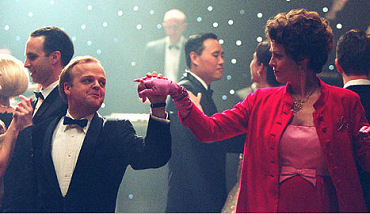
As it happened, people had no interest in seeing a second Truman Capote-writes-In Cold Blood film a year later, especially when the word began to get around that it had problems.
My opinion after seeing Infamous before the Toronto Film Festival was that it wasn’t nearly as rich and resonant as Miller and Dan Futterman‘s Capote pic. David Thomson‘s early-bird review, in which he called it close to miraculous and superior to Capote, was absolutely bizarre — and I think Thomson is brilliant. It’s obvious that Toby Jones looks more like the real Truman Capote than Philip Seymour Hoffman, but Philly is a much better actor. There are some major wrongos in the Infamous depiction of the Clutter murders. I don’t believe Capote dressed himself as a road-company cowboy in order to ingratiate himself with the Holcomb locals, as he does in McGrath’s film. I didn’t buy Daniel Craig (and the black dye he used on his hair and eyebrows) as Perry Smith for a second, and I don’t believe any of the physical stuff between Smith and Capote in McGrath’s film (including the kiss) actually happened.
If I were a Warner Independent distribution exec, I would gone out and taken a long walk after reading those Saturday morning numbers.
Variety website redesign
Holy shit, Variety‘s website has been re-designed. Airier, more white space, more widescreen-friendly…vaguely similar to the N.Y. Times redesign of a few months ago.
“Daryl Hunt” triumphs
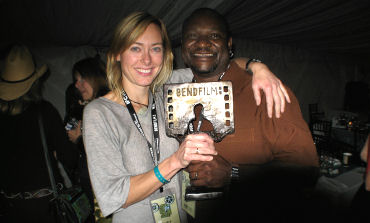
The Trials of Daryl Hunt director-producer Annie Sundberg (l.) and Daryl Hunt (r.) at last night’s Bend Film Festival award ceremony, which honored Sundberg’s documentary with both the audience award and the $10,000 “Best of Show” award. Sundberg told me that ThinkFilm has acquired Hunt for a brief theatrical distribution, and that her film will also play on HBO sometime in spring ’07.
Bring Back The Dead
Sometime in ’92, I wrote a piece for Empire magazine called “Reanimator,” about how emerging digital technologies will one day be able to bring back actors from the grave and put them in new movies in a highly believable fashion. One computer graphics guy I spoke to for the piece said this could be a reality within 15 or 20 years. And I remember how Army Archerd wrote something in his Variety column not long after that seemed to comment on the piece, and how he faintly pooh-poohed the possibilities.


Well, here we are 14 years later and a Santa Monica-based company called Image Metrics, according to a fairly thrilling article by N.Y. Times reporter Sharon Waxman, has just about gotten there.
The cyber duplications of human faces that Image Metrics has lately been composing “seem to possess something more subtle, more ineffable, something that seems to go beneath the skin,” writes Waxman. “And it’s more than a little bit creepy. And if you look at the video on the Times website that accompanies Waxman’s piece (which includes footage of Waxman herself being turned into Shrek), you’ll probably agree.
Image Metrics chairman Andy Wood says he likes to call the process “soul transference,” the key process being that “we can have one human being drive another human character…we can directly mimic the performance of a human being on a model.”
“You look and you wonder: Is it the eyes? Is it the wrinkles around the eyes? Or is it the tiny movements around the mouth?” Waxman asks. “Something. Whatever it is, it could usher in radical change in the making of entertainment. A tool to reinvigorate the movies. Or the path to a Franken-movie monster.”
At the very least, this technology will probably one day lead to a situation in which producers and studios will have a certain advantage over difficult or problematic actors, although I’m sure attorneys for actors worldwide are going to be scrambling henceforth to make sure their clients’ organic value will not be challenged or diminished in any way.
Refinements and improvements will inevitably kick in over the coming years, but Image Metrics is pretty much able right now to reconstitute any dead actor and recast him/her in a new movie opposite live actors. There are many other applications for Image Metrics technology besides bringing back the dead, but this has always held a special fascination for yours truly. Imagine a 33 year-old Cary Grant (i.e., the one who starred in The Awful Truth) starring opposite Rachel McAdams in a new comedy. Or James Dean back from the dead in a new drama directed by Chris Nolan.
“We could put Marilyn Monroe alongside Jack Nicholson, or Jack Black, or Jack White,” Wood reiterates. “If we want John Wayne to act alongside Angelina Jolie, we can do that.”
Polanski Zenovich
“I’ve never set out to diminish the seriousness of what Roman Polanski did, but it comes down to crime and punishment. How much do you have to pay for the crime? What I’ve always set out to prove is, despite what Polanski did, which was awful, he was treated unfairly by the judge. That’s the bottom line.” — Filmmaker Marina Zenovich to Charles Lyons in today’s N.Y. Times about Polanski’s unlawful-sex-with-a-minor case, which she’s been making a documentary about for eons.

Polanski and attorneys leaving Santa Monica courthouse in ’77
Zenovich’s film, “untitled and unfinished” but presumably heading for a debut at next January’s Sundance Film Festival and some kind of commercial exposure in ’07, which marks the 30th anniversary of Polasnki’s unlawful sex with a minor case, takes a closer look at the manner and tactics of the presiding judge in Polasnki’s unlawful sex with a minor case — the late Laurence J. Rittenband.
Zenovich, a very smart, extremely tenacious pro whom I’ve known since the late ’90s, tells Lyons “it is impossible to reach conclusions about Mr. Polanski without drawing Judge Rittenband into the equation.”
I’ve been hearing this for years (most lately from Polanski biographer F.X. Feeney), but judging from Lyons’ carefully phrased article, Zenovich’s conclusion in this reportedly exacting and meticulous doc is that Rittenbrand handled the Polanski case rashly. One could go so far as to describe his judicial behavior in this matter as that of an intemperate, Judge Roy Bean-ish, shoot-from-the-hip asshole.
Zenovich “describes the judge as having lived the kind of vibrant personal life easier to associate with Polanski,” Lyons writes. “‘He was never married, and he loved being kind of a swinging bachelor, juggling a couple of girlfriends at once,’ Zenovich tells him. “What’s most interesting about him is that he tried to come across as so moralistic, but eventually I found out that this was a man who had a 20-year-old girlfriend when he was 54.”
“Even from the unfinished film, it is apparent that Zenovich — who made an earlier documentary, Who Is Bernard Tapie? without the participation of its subject, the French financier and politician — has become intent, like documentary filmmakers before her, on using the form to delve deeper than the written word or television usually allow,” Lyons writes.
Produced by Jeffrey Levy-Hinte and Lila Yacoub and exec produced by Steven Soderbergh, Zenovich’s film “will likely renew the debate over whether Polanski still has a price to pay if he returns to the United States.”
Pink converse sneakers
The sum effect of coverage of Marie-Antoinette in Vanity Fair, Vogue and the New Yorker along with the Kitson Boutique window treatments, wild posting and pink Converse sneakers “is penetrating the culture,” Columbia marketing president Valerie Van Galder has told Hollywood Reporter columnist Anne Thompson.

“In just the way that Sofia didn’t treat [the story of Marie Antoinette] as a straight biopic, we’re taking a unique approach,” Van Galder explains. “We’re having fun with the marketing. The movie has captured people’s imagination.”
Surely Van Galder doesn’t mean the movie itself — which I’ve over-campaigned against, I realize — has done the capturing. What she means, I think, is that the idea of Sofia Coppola putting pink converse sneakers into a shot of Marie Antoinette’s closet (or against some other backdrop) has caught on within the culture of female movie journalists, columnists and magazine editors along with, I suppose, some of their male gay counterparts. Kind of a “you go, girl” thing.
Hollywood Bytes columnist Elizabeth Snead has written that “the modern pink footwear creates a funny, girly, rebellious moment in a frothy film about a young girl who just wants to flirt, shop and party in 18th century France. And the sneaks also work with the film’s punky pink ads and the pink-themed court parties, pink champagne, pink wigs, and pink pastries.
“More importantly, the shoes are also a bright pink emblem of Sofia’s creative and independent spirit.”
Snead reports in the same column that “someone asked Coppola about the pink tennis shoes and she explained that it was her brother Roman, her second assistant director on the film, who put them in the shot. Dunst stayed comfortable wearing pink Converse tennis shoes under her royal gowns during filming. You never see them on [her] but there is a funny shot of the tennis shoes that remains in the film.”
All Squonked Out
All Squonked Out
Life is hard all over, day after day, but every time I visit a film festival I’m reminded how especially hard it seems for documentary filmmakers. How so many of them go into deep debt to get their films made, and how most find that it takes three or four or five years to finish. And if they don’t manage to win awards at film festivals it’s that much harder to land a DVD distribution deal because awards are regarded as selling points.
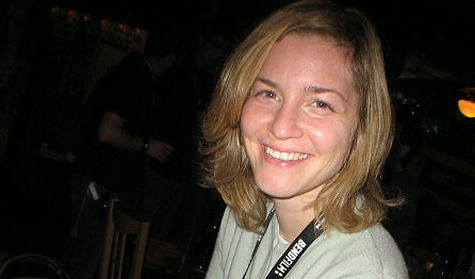
Filmmaker and script supervisor Peggy Sutton
There’s the personal satisfaction of making a film you’re happy wth, of course, plus the calling-card benefit that always helps when you’re starting your next film and looking to get the best people and/or cut the best deals. There’s the general heartwarm that comes from hearing positive reactions when your film plays before festival audiences (who tend to be generous) and all that, but for every Werner Herzog, Ken Burns or Michael Moore there are hundreds if not thousands of doc makers who reap almost no reward for their efforts, and who wouldn’t be able to stay in the game without superhuman tenacity.
Case in point: Peggy Sutton, a Manhattan-based script supervisor, and director of SQUONKumentary, a culture-clash doc about a group of Pittsburgh musicians who encounter some rough and tumble as they prepare their musical revue for a Broad- way venue. It’s an engaging, well-made piece — quirky, spirited — and I presume it’s been shown here and there since its completion sometime in late ’05. But I was nursing a feeling yesterday that Sutton might exemplify the thankless plight of the documentary filmmaker a bit more than others.
< ?php include ('/home/hollyw9/public_html/wired'); ?>
I spoke to Sutton last night about what she went through to get it made, but it was a bit noisy and everyone was drinking. I called with more questions this morning, twice, but she didn’t call back. (Probably thought I was trying to hit on her.) She’s probably shown SQUONKumentary at this and that festival, but all I know for sure besides the fact that it played here yesterday morning is what the IMDB says, which is that it showed it at the AFM (American Film Market) in September ’05.
The Bend Film Festival showing happened Friday at 11 a.m. at the Regal Old Mill, in the southern part of town. A more opportune venue would have been the Tower theatre on Wall Street, and a better time would have been in the late afternoon or evening. Obviously the festival wouldn’t be showing SQUONKumentary if they weren’t fans, but they seem to be slightly bigger fans of the some of the other films.
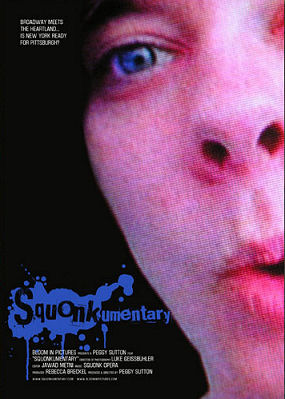
I shouldn’t be saying anything before tonight’s awards ceremony, but I can repeat that the jurors for the Bend Film Festival awards (myself among them) met yesterday and that SQUONKumentary, naturally, was one of the docs we talked overand weighed. I can’t say anything more except the obvious, which is that the competition at any well-regarded festival (and Bend definitely qualifies) is always tough.
And I was thinking as I spoke to Sutton last night…it’s hard to say it just so, especially under constrictions. But I came away from the jury deliberations with a keener appreciation for what filmmakers go through.
The performers — SQUONKers — in Sutton’s film are formally known as the Squonk Opera company, from Pittsburgh.
Sutton got to know them when she was hired to film two performances during Squonk Opera’s seven-week engagement on Broadway in 2000. They want clips to use for TV reviews and for distribution to European theatre producers.
“I was struck by them as people and as artists,” Sutton told a Pittsburgh Tribune writer in November 2005. “Theirs is not a conventional show. There’s no narrative. It doesn’t have a book or an overarching story. They think of themselves as a band first, with six members. There are visual elements and audience participation in their shows.”
Sutton’s performance footage became the core of her documentary film.
“I started editing in January 2005, which shows you how long the evolution was. I’ve been told the average time for a documentary is five years. You’re condensing lives into a three-act struggle.”
Sutton told me last night that it cost about $100,000 (I think); the IMDB says it cost about $150,000. “Are you in debt,” I asked her. “No,” she said. Obviously there’s a story there, but like I said…

SQUONKumentary shot in Manhattan, Brooklyn and Pittsburgh. The idea of beginning work on a project in 2000 and not finishing it for another four or five years sounds like a mind-blower to me. How does filmmaker “keep it up” all those years? I would think you’d get sick of the subject after a couple of years, or certainly by the third year. But four or five? Gimme a break.
Sutton’s income as a script supervisor has given her a relatively comfortable life. She’s worked on mostly indie-level films — Tape, Pollock, Election, Lawn Dogs, Songcatcher, Chasing Amy — as well as Stuart Little 2, Ash Wednesday and Men in Black 2.
O’Toole and Sharif
Peter O’Toole and Omar Sharif costarring again, for the third time! For eight or nine seconds I was entertaining the idea of actually paying to see One Night with the King, the Christian conservative right-wing Biblical costume movie, until….
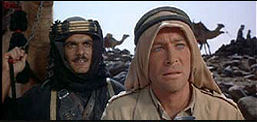
“At the very beginning, Peter O’Toole shows up for a day’s work as the prophet Samuel, looking as if he wandered in from the set of Troy; later, his old friend from Lawrence of Arabia, Omar Sharif, ambles on as well as Memucan, whispering sage advice to the king. Unfortunately they’re separated by five centuries, and never share a scene. For a movie with the most righteous of intentions, that’s perhaps the most grievous moviemaking sins of all.” — from Stephen Witty‘s review in the Newark Star-Ledger.
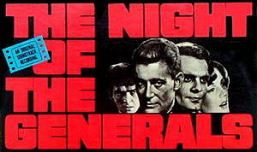
Of course, no one likes to talk about the second movie O’Toole and Sharif costarred in. It’s a 1967 World War II film called Night of the Generals, and it has a fairly shitty reputation. The Egyptian-born Sharif had to wear loads of makeup to look like a German (he plays an intelligence officer, Major Grau, looking into murder charges that involve three high-ranking generals, one of who is played by O’Toole. The only DVD mastering of the film, directed by Anatole Litvak, is a Spanish import.

